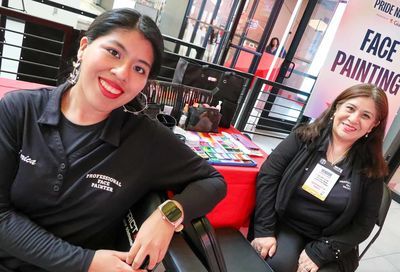Acceptance reduces suicide risk for intersex youth by more than 50%
The Trevor Project is highlighting the disproportionately high rates of mental health challenges facing LGBTQ intersex youth

Intersex youth who are also LGBTQ face disproportionately high rates of mental health challenges compared with their non-LGBTQ counterparts, according to new research from the Trevor Project.
However, acceptance by at least one parent can dramatically reduce the risk of LGBTQ intersex youth attempting suicide, especially for trans or nonbinary youth who have their pronouns respected.
Released last week, the national youth suicide prevention and crisis intervention group’s report helps fill a gap in the understanding of an often overlooked group, using data from a sample of more than 1,000 intersex youth ages 13-24.
Intersex youth comprised 3% of respondents in the Trevor Project’s 2021 National Survey on LGBTQ Youth Mental Health.
Researchers found that 48% of LGBTQ youth who are also intersex have seriously considered suicide in the last year, compared to 41% of non-intersex LGBTQ youth.
Additionally, 19% of LGBTQ intersex youth have attempted suicide, compared to 14% of their non-intersex counterparts.
Yet LGBTQ intersex youth with at least one parent who accepted their sexual orientation had 55% lower odds of attempting suicide. Those with at least one parent who accepted their gender identity had 45% lower odds.
And trans and nonbinary intersex youth whose pronouns were respected by everyone they live with had 64% lower odds of reporting suicide attempts.
The report also found that LGBTQ intersex youth — particularly those who hold multiple marginalized identities — experience higher rates of food insecurity, housing instability, depression, discrimination and victimization.
“These rates are particularly concerning given that LGBTQ youth already report much higher rates of mental health challenges and suicide risk than their straight, cisgender peers,” the report reads.
Given that the report was based on LGBTQ youth, the authors call for further research into intersex youth overall. They also advocate for the development of initiatives and programs aiming to promote the mental health of youth, emphasizing the “need to take an intersectional approach to this work.”
Because of the pathologizing of intersex variations, much research has focused on medical treatment, largely ignoring young people’s mental health and well-being.
“I think it’s important to understand that intersex youth are so much more than their bodies,” Myeshia Price, a senior research scientist at the Trevor Project, told NBC News. “By understanding them as individuals and as people, we believe that this report gives more attention to things that may be more important to them than the sort of medicalized approach to looking at who they are.”
Research has also inaccurately lumped intersex under the trans umbrella, with the report noting that while it “comes with a distinct set of inequities and stressors, both socially and medically,” it is “often conflated with gender identity and sexual orientation,” according to the report.
“Gendered bathrooms and locker rooms, binary gendered sports participation, forms and documents that only allow male or female sex markers, excluding intersex realities from health and sex education, and many other examples in which aspects of everyday life are gendered according to a binary represent stressors for intersex youth and signal that they are not permitted to be who they are,” the report reads. “These can be addressed with inclusive policy changes that directly consider intersex individuals and their needs.”
Indeed, sports policies that allow anyone to participate, all-gender bathrooms and inclusive sex ed curriculums signal to youth “that we see you, we know you’re here and we accept you for who you are,” Price said.
The report highlights that LGBTQ intersex youth reported twice the rate of a healthcare provider attempting to change their sexuality or gender identity. However, the report notes that these rates may be even higher “because such change efforts often start in infancy, with genital or gonadal surgery, making this a pervasive and particularly insidious issue.”
The report adds: “This may happen in such a systemic way, involving every person in the youth’s life, and starting from birth, that intersex youth may not even be aware that it is happening.”
Johns Hopkins University psychologist and sexologist John Money’s system for treating intersex children, called the “optimum gender of rearing” model in the 1950s, was endorsed by the American Academy of Pediatrics.
However, in response to activism by intersex people, some doctors have recently begun re-evaluating standard medical protocols to change youth’s appearance through surgery and hormonal therapy.
This year, Robert H. Lurie Children’s Hospital of Chicago, Lurie Children’s Hospital in Boston and New York City Health + Hospitals announced that they would stop performing certain surgeries on intersex children.
Despite the bleakness of many statistics, Price stressed that the report offers hope, underscoring the benefits of acceptance and affirmation.
“The best thing that we could do for intersex youth is to be accepting and provide that protective and supportive environment for them,” she said.
Read More:
Jeopardy! champ Amy Schneider reveals how Shakespeare helped her come out as transgender
Former middle school principal claims she was demoted for refusing to take down Pride flag
Gay lawmaker blames Trump for Britain feeling ‘less safe’ for LGBTQ people
Support Metro Weekly’s Journalism
These are challenging times for news organizations. And yet it’s crucial we stay active and provide vital resources and information to both our local readers and the world. So won’t you please take a moment and consider supporting Metro Weekly with a membership? For as little as $5 a month, you can help ensure Metro Weekly magazine and MetroWeekly.com remain free, viable resources as we provide the best, most diverse, culturally-resonant LGBTQ coverage in both the D.C. region and around the world. Memberships come with exclusive perks and discounts, your own personal digital delivery of each week’s magazine (and an archive), access to our Member's Lounge when it launches this fall, and exclusive members-only items like Metro Weekly Membership Mugs and Tote Bags! Check out all our membership levels here and please join us today!




















You must be logged in to post a comment.